Medical Disclaimer: This article is for informational purposes only and does not replace professional veterinary advice. Always consult your veterinarian before beginning any new exercise or training regimen with your dog. Canine acupuncture should only be performed by a licensed veterinarian trained in veterinary acupuncture.
Table of Contents
Introduction
Canine acupuncture is a growing and effective therapy that supports your dog’s health by promoting natural healing through the stimulation of specific points on the body. As a small-animal veterinarian in Ottawa with over eight years of clinical experience, I have seen firsthand how canine acupuncture can improve mobility, reduce pain, and help manage chronic conditions in dogs. Rooted in Traditional Chinese Veterinary Medicine, this therapy works by balancing the flow of energy, or Qi, along pathways called meridians. Canine acupuncture not only eases symptoms but targets underlying imbalances, offering a holistic and complementary approach to conventional veterinary care. In this guide, you’ll learn about the key principles, points, safety, and practical uses of canine acupuncture to help your dog thrive.
Key Takeaways
- Canine acupuncture is a safe, natural therapy that stimulates specific body points to promote healing, balance energy flow (Qi), and reduce pain.
- It is effective for treating musculoskeletal issues, neurological conditions, digestive problems, respiratory ailments, skin diseases, and more.
- Acupuncture points are located along meridians, energy pathways connecting organs and systems in dogs.
- Common methods include dry needling, electroacupuncture, laser therapy, and moxibustion.
- Certified veterinary acupuncturists with formal training ensure safe and effective treatments.
- Typical Canadian treatment costs range from $50 to $150 per session.
- Pet owners can learn simple acupoint locations at home to support ongoing care.
What Is Canine Acupuncture?
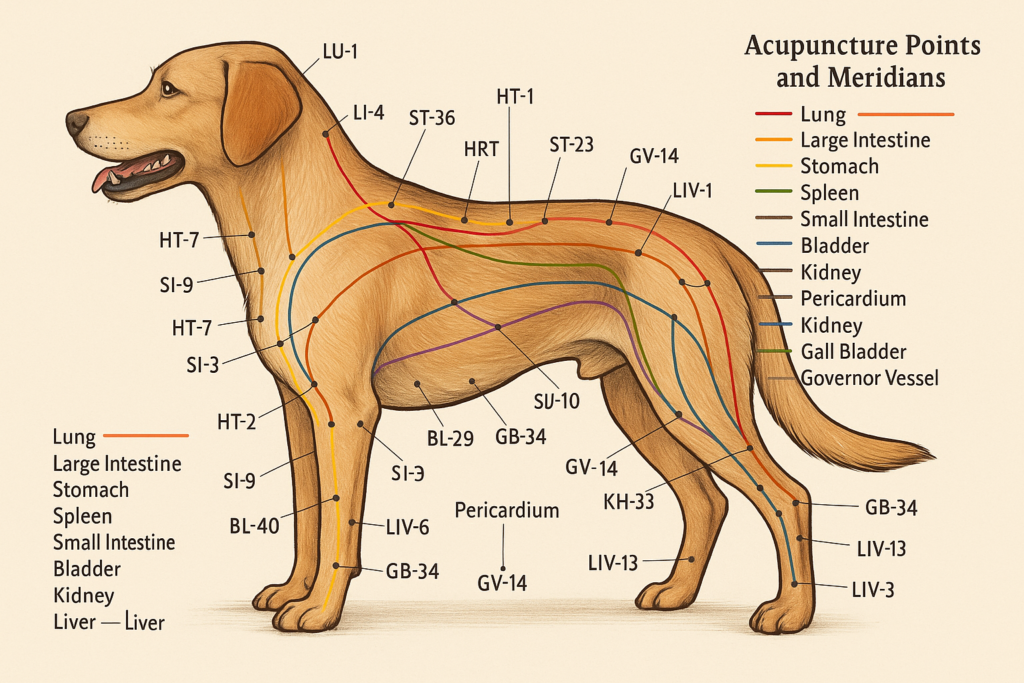
You can also visit: https://doglifeexpert.com/2025-top-benefits-of-agility-training-for-dogs/
Definition and Clinical Mechanism
Canine acupuncture is a therapeutic technique that involves inserting fine, sterile needles into specific points on a dog’s body to stimulate healing and balance. These points lie along energy pathways called meridians. When stimulated, canine acupuncture triggers nerve signals that travel to the spinal cord and brain, promoting the release of natural pain-relieving chemicals like endorphins and serotonin. This neuromodulation effect helps reduce inflammation, improve circulation, and support the body’s own repair mechanisms.
My Clinical Experience with Acupuncture
In my veterinary practice in Ottawa, I have seen numerous dogs benefit from canine acupuncture, especially those with arthritis, nerve injuries, or chronic pain. One senior Labrador with hip dysplasia regained mobility and comfort after just a few treatments. Canine acupuncture is not just about symptom relief—it often improves overall vitality and well-being, complementing traditional veterinary medicine effectively.
Traditional Chinese Veterinary Medicine (TCVM) Overview
Canine acupuncture is grounded in Traditional Chinese Veterinary Medicine (TCVM), an ancient holistic system that views health as the harmonious flow of vital energy called Qi. TCVM emphasizes balance between Yin and Yang forces and the smooth movement of Qi through meridians. Disease arises when Qi is blocked or imbalanced, so canine acupuncture aims to restore this flow and energetic harmony for lasting health benefits.
The Concept of Qi and Yin-Yang in Dogs
Qi is the essential energy that circulates through a dog’s body, nourishing organs and tissues. Yin and Yang are opposing but complementary forces that regulate body functions like temperature, activity, and rest. In canine acupuncture, practitioners assess whether a dog’s symptoms relate to excess or deficiency of Yin or Yang, guiding point selection to rebalance these forces and promote healing.
The Canine Meridian System
Overview of Meridians and Their Functions
Meridians are invisible energy channels that run throughout a dog’s body, guiding the flow of Qi to maintain health. Canine acupuncture points are located along these meridians, and stimulating them helps release blockages, restore energy flow, and activate healing. Think of meridians as highways connecting different organs and systems, so a point on a limb can influence distant areas like the abdomen or head.
The 12 Major Meridians and Their Roles
Dogs have 12 major paired meridians, each linked to specific organs or functions:
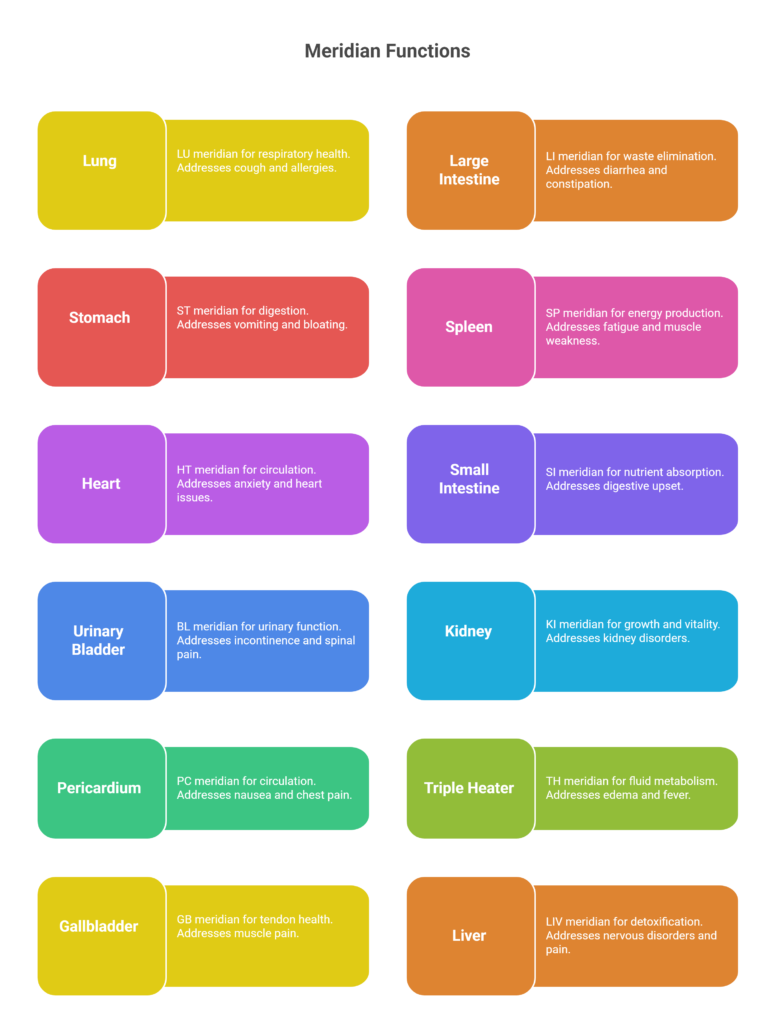
Extraordinary Channels
In addition to the 12 major meridians, there are eight extraordinary channels that regulate overall constitutional health and energy storage. Notably, the Governing Vessel (GV) runs along the back midline, and the Conception Vessel (CV) along the belly midline. These channels have broad effects on the nervous system and help manage chronic or systemic conditions.
How Acupuncture Points Interact with the Nervous System
Acupuncture points often coincide with nerve bundles and motor points. When stimulated, they send signals through the nervous system to the brain and spinal cord, triggering the release of natural opioids and neurotransmitters. This explains the powerful pain relief and systemic effects of canine acupuncture beyond local tissue changes.
Key Canine Acupuncture Points and Locations
General Principles for Locating Points
Accurate point location is crucial for effective canine acupuncture. Points are usually found in small depressions between muscles, tendons, and bones. On the head, they often align with nerve exits like the supraorbital or infraorbital foramina. Many points correspond with nerve branching sites or motor endplates, which explains their therapeutic power when stimulated.
https://www.chi.university/program/veterinary-acupuncture
Master Acupoints and Their Therapeutic Effects
| Acupoint (Meridian-Number) | Location | Primary Uses |
|---|---|---|
| ST-36 (Zusanli) | 3 cun below the knee on the tibialis muscle | Digestive issues, pain relief, energy balance |
| LI-4 (Hegu) | Between 1st and 2nd metacarpal bones | Facial pain, inflammation, immune modulation |
| SP-6 (Sanyinjiao) | 3 cun above medial malleolus on tibia | Urogenital disorders, fatigue, digestive complaints |
| BL-40 (Weizhong) | Center of popliteal crease | Back and hip pain, lameness |
| LU-7 (Lieque) | Above wrist crease near radius bone | Respiratory issues, neck pain |
| PC-6 (Neiguan) | 2 cun above wrist crease between tendons | Nausea, vomiting, cranial abdominal discomfort |
| GV-20 (Baihui) | Top of head, midline between ears | Sedation, neurological conditions, anxiety |
Meridian-Specific Points and Uses
Detailed charts are available that provide precise anatomical locations and specific therapeutic indications for each meridian’s acupoints. For example, the Lung meridian points help with respiratory and skin conditions, while Kidney meridian points support reproductive health and vitality.
Ah Shi and Non-Meridian Points
Ah Shi points are tender or reactive spots that may not lie on traditional meridians but represent areas of pain or muscle tightness. These points are often targeted for customized treatments to address specific discomforts or injuries unique to each dog.
Common Conditions Treated with Canine Acupuncture
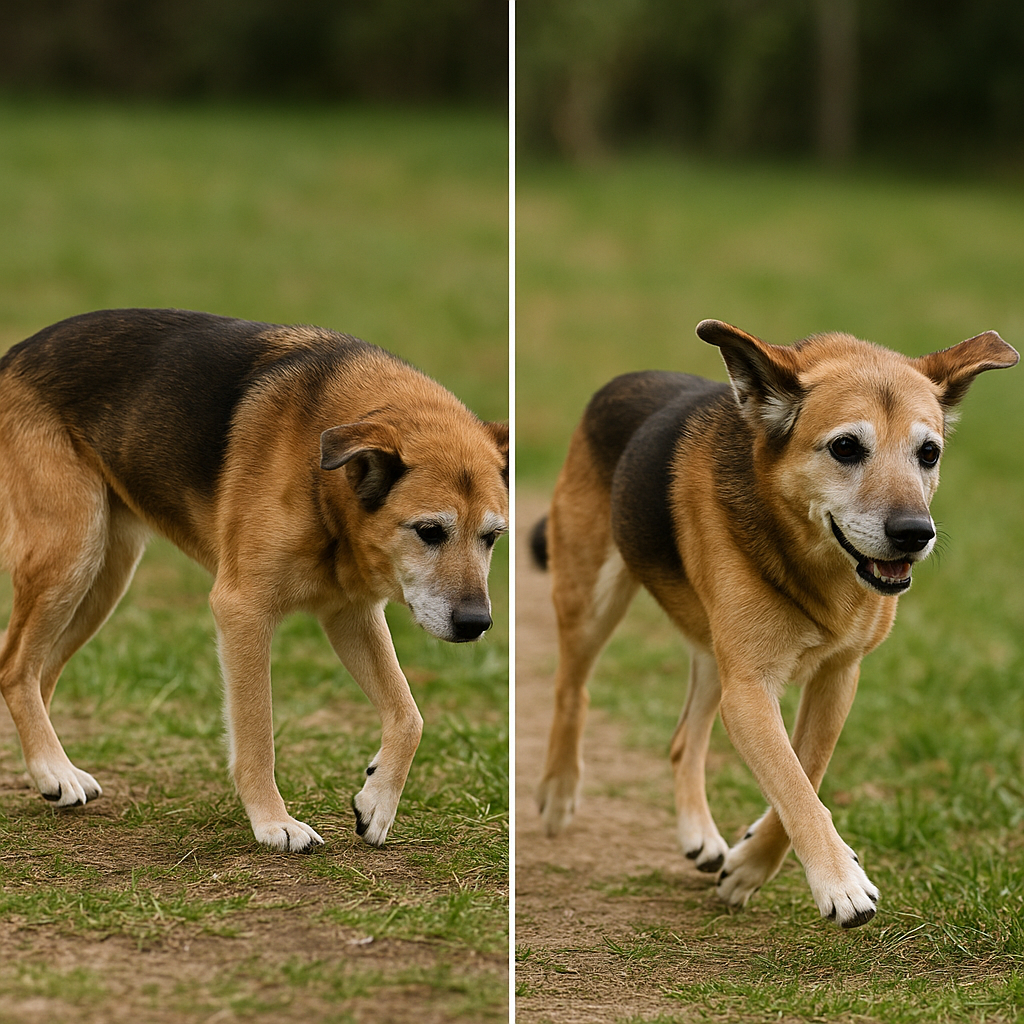
Musculoskeletal and Neurological Disorders
Canine acupuncture is highly effective for managing arthritis, hip dysplasia, intervertebral disc disease (IVDD), nerve injuries, paralysis, back pain, lameness, and tendon injuries. It promotes nerve regeneration and reduces inflammation and pain. For example, points like ST-36, BL-40, and LIV-3 target pelvic limb issues, while LI-4 and LU-7 address thoracic limb pain. Acupuncture complements conventional treatments and can improve mobility and quality of life significantly.
Gastrointestinal Issues
Acupuncture supports digestion and treats vomiting, diarrhea, constipation, nausea, inflammatory bowel disease (IBD), and fecal incontinence. Points along the Stomach and Spleen meridians, such as ST-36 and SP-6, regulate GI function. PC-6 is especially helpful for nausea and esophageal motility disorders. The therapy helps balance the autonomic nervous system, influencing the gut-brain axis for better digestive health.
Respiratory and Skin Conditions
Respiratory problems like asthma, chronic cough, sinus infections, and allergic bronchitis respond well to canine acupuncture. The Lung meridian points enhance immune defense and respiratory function. Skin conditions including atopic dermatitis, chronic ear infections, and non-healing wounds can improve with acupuncture. Points such as LI-4, LI-11, and LR-3 boost circulation and immune responses.
Pain Management
Pain relief is the most common reason owners seek canine acupuncture. It’s effective for acute and chronic pain, post-operative discomfort, cancer-related pain, and phantom limb pain after amputations. Acupuncture stimulates natural opioids and serotonin release, providing both immediate and cumulative analgesic effects. Points like LI-4, LIV-3, ST-36, and BL-60 are frequently used for general and inflammatory pain.
Other Conditions
Canine acupuncture can aid dogs with hormonal or metabolic diseases such as Cushing’s syndrome, hypothyroidism, diabetes, and Addison’s disease. It supports liver and kidney health, urinary and fecal incontinence, trauma recovery, dental pain, epilepsy, and neurological disorders. This broad range highlights the systemic balancing effects of acupuncture on canine health.
Acupuncture Techniques Used in Dogs
Dry Needle
Dry needling is the classic acupuncture method, involving the insertion of thin, sterile needles into acupoints. Needles are typically left in place for 10 to 30 minutes. This technique is effective for stimulating local and systemic healing responses.
Electroacupuncture
Electroacupuncture applies a gentle electrical current through inserted needles to enhance stimulation. It offers stronger and longer-lasting pain relief, especially for nerve injuries and chronic pain. Low frequencies (2-10 Hz) are more effective for inflammatory pain than higher frequencies.
Laser and Aqua-Acupuncture
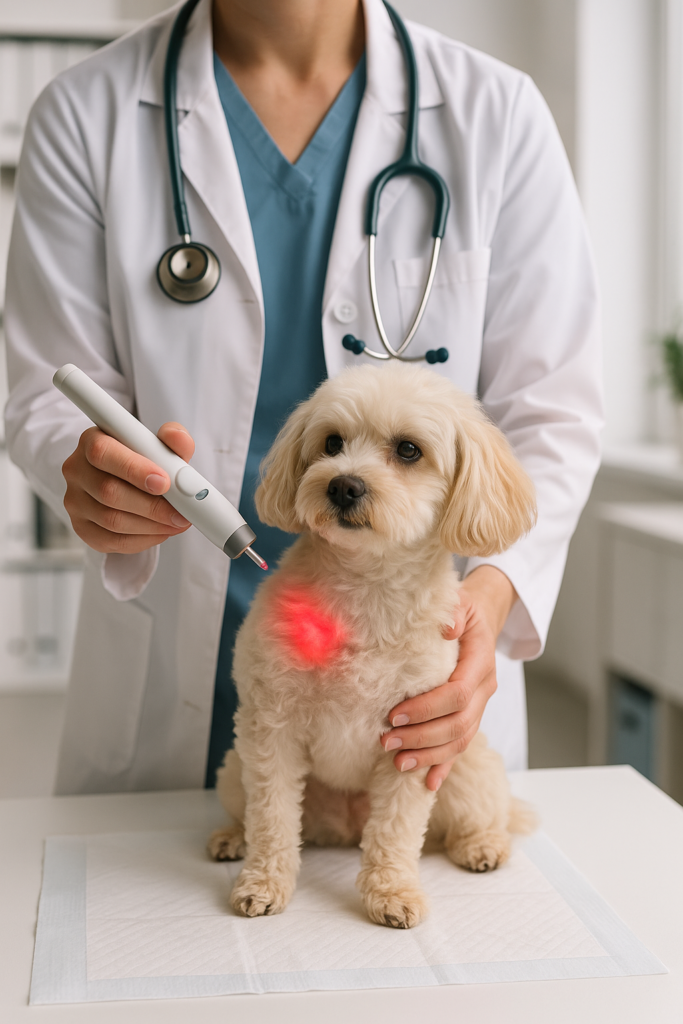
Laser acupuncture uses low-level laser beams to stimulate acupoints without needles, ideal for sensitive or needle-phobic dogs. Aqua-acupuncture involves injecting small amounts of substances like Vitamin B12 into points, combining acupuncture with medicinal effects.
Moxibustion and Material Implantation
Moxibustion uses the heat from burning dried mugwort near acupoints to warm and stimulate energy flow. Material implantation places small sterile materials (e.g., gold beads) at acupoints to provide ongoing stimulation, especially for chronic conditions.
Safety, Contraindications, and Professional Standards
Safety Profile and Minor Side Effects
Canine acupuncture is generally very safe when performed by licensed veterinarians trained in acupuncture. Minor side effects may include temporary tiredness, mild soreness, muscle twitching, or slight bleeding at needle sites, but these resolve quickly. Serious complications like infections or broken needles are extremely rare.
Important Contraindications
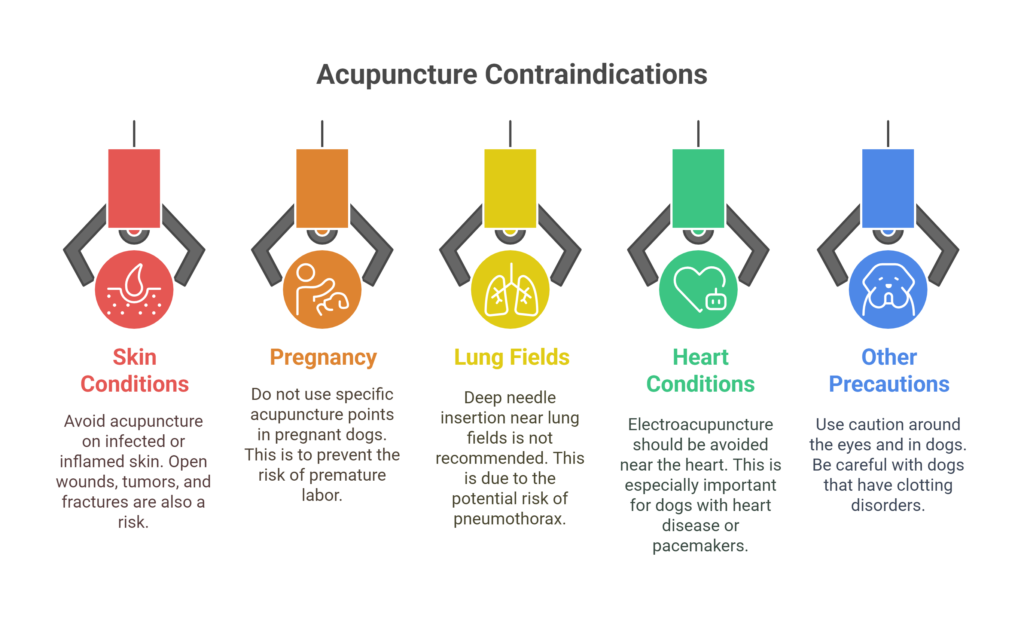
Certification and Professional Requirements
For safety and efficacy, canine acupuncture should only be performed by licensed veterinarians with formal certification, such as from the International Veterinary Acupuncture Society (IVAS) or Chi University. Certified veterinary acupuncturists complete rigorous training, clinical practice, and ongoing education, ensuring they apply acupuncture appropriately and skillfully.
5-Minute At-Home Acupoint Checklist for Pet Owners
While professional acupuncture requires training, you can gently stimulate some accessible acupoints at home to support your dog’s well-being:
- LI-4 (Hegu): Between the first and second metacarpal bones on the front paw. Gently massage to relieve pain and inflammation.
- ST-36 (Zusanli): About 3 finger widths below the knee on the outside of the hind leg. Stimulates digestion and energy.
- SP-6 (Sanyinjiao): Located above the inner ankle on the hind leg. Supports urinary and reproductive health.
- GV-20 (Baihui): At the top of the head, on the midline between the ears. Gently rub to help calm anxiety.
Always be gentle, observe your dog’s reaction, and consult your veterinarian before trying home stimulation.
Typical Canadian Costs of Veterinary Acupuncture
| Service | Typical Cost (CAD) | Notes |
|---|---|---|
| Initial Consultation | $80 – $150 | Includes exam and treatment plan |
| Follow-up Acupuncture | $50 – $100 per session | Most dogs require multiple sessions |
| Electroacupuncture | Additional $20 – $30 | May be combined with standard needling |
| Laser Acupuncture | $60 – $100 per session | Non-invasive option |
Costs vary by clinic and region. Some insurance plans may cover acupuncture under complementary therapies.
Prevention Tips to Support Canine Health with Acupuncture
- Maintain regular veterinary check-ups to catch imbalances early.
- Combine acupuncture with balanced nutrition and appropriate exercise.
- Manage stress with calming routines and safe socialization.
- Use acupuncture preventatively to support immune health and mobility, especially in aging dogs.
- Monitor and avoid exposure to toxins or allergens that may disrupt Qi flow.
Early and ongoing care can enhance your dog’s vitality and prevent chronic conditions.
Frequently Asked Questions (FAQs)
Q1: Is canine acupuncture painful for dogs?
No, most dogs tolerate acupuncture very well. The needles are very thin, and many dogs show relaxation or even fall asleep during treatment.
Q2: How many sessions does a dog typically need?
It varies by condition, but many dogs show improvement within 3 to 6 sessions. Chronic issues may require ongoing maintenance treatments.
Q3: Can acupuncture be used alongside conventional treatments?
Yes, canine acupuncture is often combined with medications, surgery, or physical therapy to enhance healing and reduce pain.
Q4: Are there any risks or side effects?
Minor side effects like temporary soreness or tiredness can occur, but serious complications are rare when performed by certified veterinarians.
Q5: Can puppies receive acupuncture?
Yes, acupuncture can be safely performed on puppies to support growth, immune health, and treat certain conditions, with adjustments made for size and sensitivity.
Conclusion
Canine acupuncture offers a safe, effective, and holistic approach to supporting your dog’s health by balancing energy flow and stimulating natural healing. Rooted in Traditional Chinese Veterinary Medicine and supported by modern science, it addresses a wide range of conditions—from pain and neurological disorders to digestive and respiratory issues. As a veterinarian with years of clinical experience, I encourage pet owners to seek treatment from certified veterinary acupuncturists who combine anatomical precision with a deep understanding of energetic balance. By integrating canine acupuncture with conventional care, you can help your dog achieve better comfort, mobility, and overall well-being.




